Anne Teresa De Keersmaeker’s The Six Brandenburg Concertos at Park Avenue Armory, October 1 through 7.
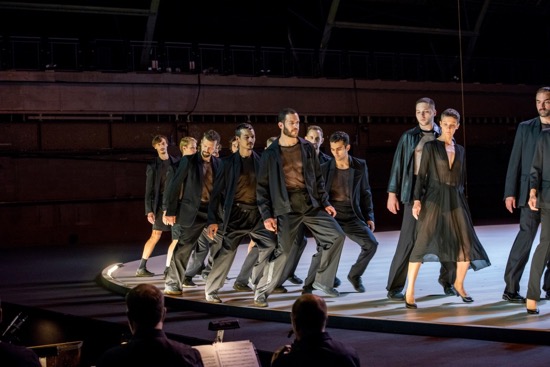
Members of Anne Teresa De Keersmaeker’s Rosas with the B’Rock Orchestra perform The Six Brandenburg Concertos. Photo: Stephanie Berger.
In 1721, Johann Sebastian Bach, then thirty-six years of age, sent the Margrave of Brandenburg some concertos that he had composed with the following message: “Your Highness deigned to honor me with the command to send Your Highness some pieces of my Composition: I have in accordance with Your Highness’s most gracious orders taken the liberty of rendering my most humble duty to Your Royal Highness with the present Concertos, which I have adapted to several instruments. . . .”
Sitting in the Park Avenue Armory, watching sixteen members of Anne Teresa De Keersmaeker’s Belgium-based company dance to all six Brandenburg concertos for an intermissionless two hours, you may be aware not just of the coming and going of dancers on the huge disk of a stage, but of the twenty members of the baroque ensemble B’Rock entering and leaving what serves as an orchestra pit. There go the oboe players. The three violists take a break before returning. The cellos aren’t needed now, but the recorders are. . . .
De Keersmaker’s choreography is as precise and as surprising as the music. The notation of the opening of Concerto No. 3 (said to be in Bach’s hand), which adorns the first pages in the very large paper program, is also a marvel of beauty and clarity. The concertos are played in order, with Lav Crnčević walking into the arena to announce each by holding up a sign on a stick. He wears a different brightly colored outfit each time. The sixteen dancers, however, are dressed in black street clothes (by An D’Huys), parts of which they may take off or put on as the performance progresses. Music director and lead violinist Amandine Beyer hasn’t yet signaled the musicians to play when the futuristic lighting apparatus by Jan Versweyveld rises from centerstage where it squats, and we hear the light percussion of the women’s high-heeled shoes as the cast files in and forms a horizontal line facing us.
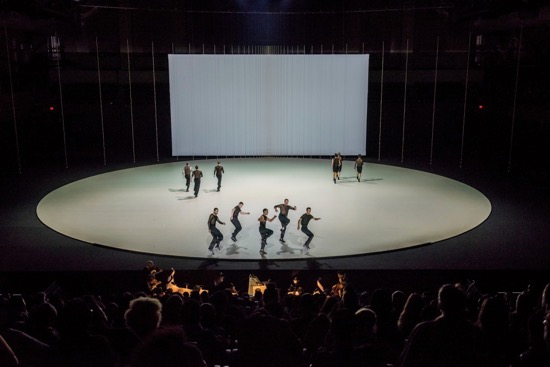
The Six Brandenburg Concertos at the Park Avenue Armory. Photo: Stephanie Berger.
I hadn’t read all the program essays at this point in the evening. I knew neither the details of De Keersmaeker’s floor patterns (spiraling pentagrams with three possible superimposed designs: a row, a zigzag, and a circle), nor the fact that certain movements and patterns inspired inspired by an ABC that had shaped a series of television interviews with philosopher Gilles Deleuze (A as in Animal, B as in Boire, C as in Culture—all the way to Z as in Zigzag). What we see at first are people walking toward us and away from us, again and again. They seem to be treading the continuo line provided by the music’s cembalo and other instruments. You can begin to notice differences among the sixteen dancers as well as similarities; as they turn to walk away from us, for instance, you can focus on how they let their glances linger for a second on the musicians below them. Now they pause at times, now they lean a bit to one side. The line keeps walking, whether or not some people have temporarily left it.
It interests me that the audience—a large one—is quiet and still and remains so throughout the evening. Watching the choreography as it develops, I don’t try to figure out its rules, but perhaps others like me are gripped by the sense of purpose that the performers convey. I’ve had that feeling before when watching, say, dances from a culture unfamiliar to me; I don’t worry that I won’t “get” the logic.
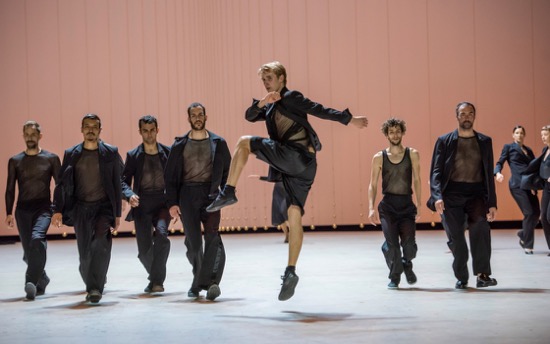
Anne Teresa De Keersmaeker’s The Six Brandenburg Concertos. (L to R): Mark Lorimer, Michael Pomero, Robin Haghi, Thomas Vantuycom, Frank Gizycki (jumping), Jason Respilieux, Boštjan Antončič. At back: Cynthia Loemij and Samantha van Wissen. Photo: Stephanie Berger
Bach’s Brandenburg No.1 is a complex concerto. Allegro, Adagio, Minuets, a Polacca, with hunting horns, oboes, and a bassoon joining the strings. And complexities develop in the smooth, grounded dancing. The dancers are intent on their jobs, but relaxed about them. . .unforced. Sue Yeon Youn goes to the edge of the stage, takes off her jacket and her shoes and lays them neatly on the floor. Nimble Jason Respilieux, breaking into more complex movement, is caught and lifted by three of the other men. Samantha van Wissen falls against a man but recovers. One or two or more people may suddenly tear around in a circle. Sometimes they lope to a new spot, free but precise. They jump or hop. I become enamored of the way one person without fanfare drops into a pattern that others have established, as if his or her doing so were pleasantly inevitable (which, of course, it is to someone following what Bach and De Keersmaeker have stirred up).
I recognize performers I’ve admired before. Tall, lanky Igor Shyshko, whose hair flops when he takes to the air. Broody, powerful Boštjan Antončič. Delicately steely Marie Goudot. At times, over the course of the evening, Thomas Vantuycom seems to anchor the action or investigate it in his own way. Carlos Garbin, Cynthia Loemij, Robin Haghi, Mark Lorimer, Michael Pomero, and Sandy Williams are familiar to me as well. I don’t think I’ve seen Frank Gizycki before, or Luka Svajda and Jakub Truszkowski. All perform splendidly.
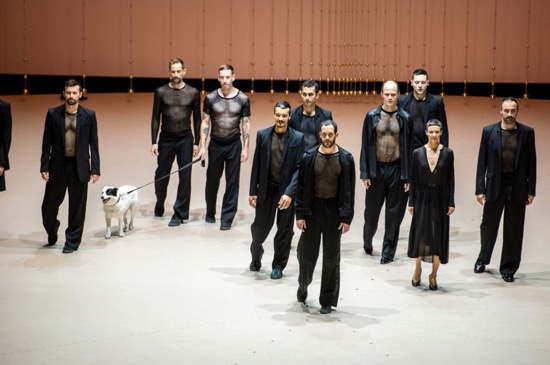
The Six Brandenburg Concertos. (L to R): Jakub Truszkowski, Stella (the dog), Mark Lorimer, Sandy Williams, Michael Pomero, Robin Haghi, Thomas Vantuycom, Carlos Garbin, Lav Crnčević, Marie Goudot, Boštjan Antončič. Photo: Stephanie Berger.
As the first concerto’s final minuet nears its end, and the dancers have done with their swaying, twisting, and leaning, they’re back in their initial lineup, ready to walk toward us again and for some of them to toss their jackets aside. On this walk, they’re joined by a small white dog whose one black spot allies him with the human performers’ costumes. We laugh. But this dog is telling us something. Trotting along beside Williams, who holds the leash—he/she is not exactly in time with Bach but with him in spirit, and whenever the walkers pause, she/he stops and waits motionless. Let’s hear it for freedom within discipline.
As the evening progresses, new movements creep in and recur. The six agile performers who’ve been running, spinning, and hopping in Concerto No. 2’s opening allegro introduce into its adagio a gesture in which one straight arm is bisected by the other right-angled one. The cast of Concerto No. 3—all men—may bunch their legs up under them when they jump. They sidle and stagger, and some of them dance incredibly rapidly before hastening toward us and halting on a dime. In Concerto No. 4, we see for the first time, full back somersaults and half ones. Goudot and Youn roll on the floor as the music jitters. People lift one another, emphasizing the pull between sky and ground. They race in a big circle. Brandenburg No. 5’s dancers swivel their hips and let their shoulders respond. Whipped turns get recycled.
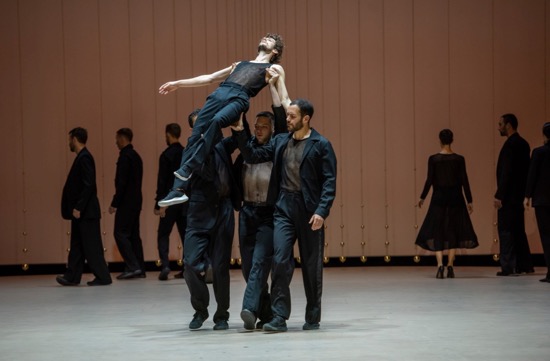
Jason Respilieux lifted in Anne Teresa De Keersmaeker’s The Six Brandenburg Concertos. Photo: Stephanie Berger.
De Keersmaeker, like Bach, is aware of needed contrasts. He chose his instruments for each concerto; she chose her dancers and their actions. In Concerto #5, the voices of flute and solo violin weave together that of a cembalo. In the slow movement, there’s very little traveling done by six dancers. Their moves seem pacified; they pause often, until the lighting source hanging over them blazes with what suggests a red star; inciting speed, it then turns yellow.
The sixth and final concerto, a feast of stringed instruments, gradually brings on all the dancers, as if this were a party they were hopeful about, even though various of them periodically disappear. Respilieux has come wearing a flimsy black dress. We glimpse much of what we’ve seen earlier, but through a different lens. The dancers lunge, lie down, kneel, gesture. They balance precariously, become unsteady. You can feel innocence; you can imagine despair. They walk facing different directions or run like crazy. They reach out, become a throng. And then they race away and it’s over.
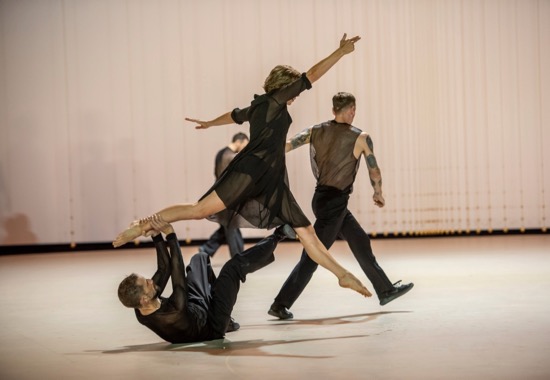
Mark Lorimer on floor, Samantha van Wissen leaping, Sandy Williams striding. Photo: Stephanie Berger
The notion of walking, whether forthright or zigzagging, fuels the whole of The Six Brandenburg Concertos. Almost always, someone has to be doing it, even when a line of people has diminished to one or two people. They’re the music’s continuo made visible But you don’t get the impression that walking in a line is a rule forced on members of this community. Often enough, they fall away from it or rest a while or take a little vacation. And the intermittent solos—brief or extended—seem like reconsiderations of what’s been happening, or struggles to understand something quite personal. Watch the terrific Antončič or Vantuycom or Respilieux or Gisycki, or any of others dancing alone, and you feel that they’re “speaking” in a language foreign to you, but one that, deep down, you understand.
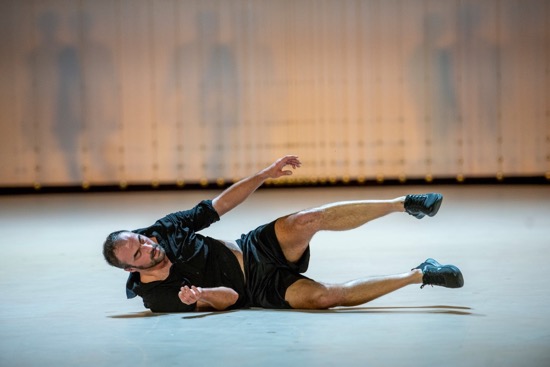
Boštjan Antončič in Anne Teresa De Keersmaeker’s The Six Brandenburg Concertos. Photo: Stephanie Berger.
The audience rose to its feet on opening night to applaud the dancers, the musicians, and De Keersmaeker. Maybe people were simply glad to stand up after two seated hours, but pressing together toward the exit, they seemed akin to jubilant sports fans whose team had won.

Thank you for the vicarious pleasure of enjoying the piece 3,000 miles away. How your vivid descriptions and keen insights make me wish I could sit on your shoulder and listen in on your thoughts.